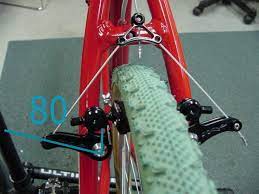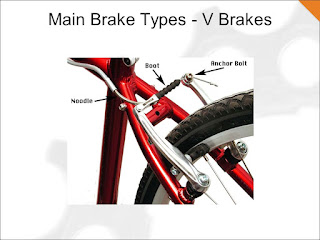One of my students sent me this image to remind me to do a more in-depth explanation of rim brakes... so here we go:
On road bikes, with narrow wheel rims, road bike caliper brakes are most common, even with the advent of disk brakes. Despite bike industry hype, caliper rim brakes are effective for road bikes. They are also lighter, and simpler to maintain (and you don't need to be a pro mechanic to do it... which may be part of the reason so many pro mechanics push disk brakes). Disk brakes are also prone to heat problems, for example when "riding" the brakes on long descents; I have heard few complaints aboout heat problems for rim brakes among road bikers. (Edit 3/18/22: I have just gotten word of one more of these complaints.)
The older form of these rim brakes have a single pivot with two elements:
(Yummy detailing on that lug, right?) These brakes are a little more difficult to adjust than the newer dual-pivot, three-element brakes:
The extra element means these can be centered more easily than the single-pivot relatives.
For wider rims, cantilever brakes were developed.
The stopping power on these, however, is not ideal; as you pull harder on the lever, more energy goes into lifting the cable, and less into pulling the brake pad into the rim, because of changes in the "up vector" and "in vector". They were largely replaced by "U brakes":
These reduced, but did not eliminate, the problem of the direction of pull being at right angles to the direction you want the pads to go. That problem is almost eliminated by "V brakes".
The picture shows the noodle (of course it's too small; click on the picture to see a bigger version). The noodle changes the direction of cable pull from straight up to the lever, to straight across the calipers, so that almost all of your effort (except for that lost to friction) goes into pushing the brake pad against the rim.
Now, for off-road bikes, especially mountain bikes, rims can get wet and muddy, reducing the effectiveness of rim brakes; for these, the newfangled disk brakes make sense, since the disk is higher up on the wheel, and so is farther away from the mud and muck than the braking surface of the rim.
But I'm a retrogrouch who still uses friction shifting. What do I know?






No comments:
Post a Comment